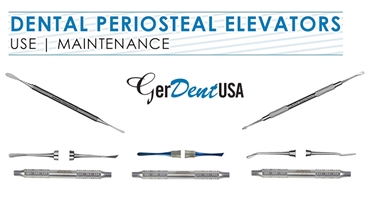Guide For Efficiently Using Periosteal Elevators

A dental extraction is a common but painful and time-consuming procedure. However, patients prefer dental extraction for long-term relief from tooth problems.
A dental extraction is a common but painful and time-consuming procedure. However, patients prefer dental extraction for long-term relief from tooth problems. As a result, a dentist has to go through this procedure several times per day. So, they prefer to use ergonomic tools such as a periosteal elevator to make the procedure less complex.
Dentistry has come a long way in the last few decades. Previously, it was difficult to extract a tooth directly with forceps or any dental tool.
The invention of the periosteal dental elevator has simplified the tooth extraction procedure for dentists. Now, they can perform oral surgeries with less possible trauma. Moreover, these are very useful and unique oral instruments that make a dentist's job easier and more efficient.
Let's go over the specifics of periosteal elevators, how to use them, and how they can help with dental procedures.
What are Periosteal Elevators?
The dental periosteal elevator is a useful dental tool that assists dentists in tooth extraction procedures. This double-ended tool has a long slender shape along with slightly curved and thin working ends.
The tool helps to separate the periosteum from the tooth. Its fine and sharp tip is ideal for uplifting the thick, soft tissue flaps for easy tooth extraction.
How to Operate Periosteal Elevators?
The surgical periosteal elevator assists dentists during oral and maxillofacial surgical procedures. The tool is easy to use during the extraction procedures and delivers the maximum force. Dentists can use it to impart forces on tooth particles in order to luxate the tooth. This is a good way to expand the tooth socket so you can easily remove it without harming the nearby tissues.
In addition, its ergonomic shape can raise the tissues around the tooth in a cervical manner to provide obvious exposure to the surgical site. This way, the operator can efficiently and feasibly proceed and complete the tooth extraction procedure.
Instructions While Operating Periosteal Elevators
There are a few things to consider before using periosteal dental elevators. First, the operator should take precautions to avoid damaging the adjacent tooth.
Avoid Excessive Force
Avoid applying greater force to the instrument while operating it on the target area. It can damage the surgical site and make the procedure more complex.
Grasp Tool Correctly
Carefully grab the instrument from the serrated area to avoid any slippage. If the dentist does not grasp the tool correctly, there is a chance of damage while raising the flaps.
Apply At the Exact Location
When imparting force, dentists should apply the force at the exact point. Even a millimeter of deflection can cause a bone fracture. So, make sure to apply force at the exact point while manipulating tissues. Otherwise, it can fracture the alveolar bone.
Sharp Rough Tips
The most important thing that needs to be considered before use is the tip sharpness. The elevator's working ends get rough after being used in a surgical procedure. So, make sure to keep the instruments' tips sharp and pointed to avoid shredding the tissue flaps.
Handling & Positioning of Periosteal Elevators
As you are aware, the effectiveness of any surgical procedure is primarily determined by the correct handling of the instrument. Especially for the surgical periosteal elevator, the correct handling and positioning are crucial in the luxation process. So, continue reading
below to learn more about elevator positioning:
The dorsal surface of the instrument’s working end needs to contact the stiff intraoral points.
The tip's ventral surface should make contact with the hard point of the targeted tooth.
Dentists need to be aware of the exact direction, elevator contact points, and also the magnitude of the tip force.
The sectioning of the tooth or the removal of bone provides more room for the positioning of elevators.
Maintenance Of Periosteal Elevators
Regular care and maintenance are compulsory processes for dental surgical instruments. In addition, healthcare professionals recommend routine inspection of the tools as it is a matter of the patient's overall health.
Dentists use periosteal elevator surgical instruments almost on a daily basis. That’s why they should also need to thoroughly inspect its efficacy and sharpness. The elevator’s tip needs to be sharp before using it in dental extraction procedures.
Conclusion
Dentists should use the periosteal elevator with caution to get the most out of them. However, it is an essential dental surgical tool, and its correct use can feasibly and smoothly remove the impacted tooth.
If you're looking for these versatile instruments, GerDentUSA is a good place to start. They have been producing and selling dental instruments for over three decades. They provide dentists with professional dental tools to make their work easier and more precise.
The best thing about them is that they manufacture ergonomic dentistry tools with German stainless steel, making instruments more robust and long-lasting. So go ahead and upgrade your dental clinic with some cutting-edge tools to better serve your patients.
FAQs
What Is the Difference Between an Anglevator and a Periosteal Dental Elevator?
A periosteal dental elevator is a unique dental surgical tool to luxate the tooth before tooth extraction. On the other side, the anglevator is an innovative multifunctional tool, as it performs the functions of six instruments. It is the combination of six dental tools, including a luxator, proximator, periotome, crane pick, elevators, and chisels.
Why Handling the Periosteal Dental Elevator is Important for Dental Procedures?
Incorrect handling of the instrument enhances the chances of slippage during the dental procedure. This can lead to significant complications and more painful procedures. That’s why dentists need to be careful while holding the instrument in surgical operations.

